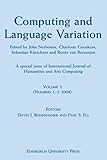Computing and Language Variation : International Journal of Humanities and Arts Computing Volume 2 / Charlotte Gooskens, Renée van Bezooijen, John Nerbonne, Sebastian Kürschner.
Material type: TextPublisher: Edinburgh : Edinburgh University Press, [2022]Copyright date: ©2009Description: 1 online resource (268 p.) : 59 B/W illustrationsContent type:
TextPublisher: Edinburgh : Edinburgh University Press, [2022]Copyright date: ©2009Description: 1 online resource (268 p.) : 59 B/W illustrationsContent type: - 9780748640300
- 9780748641642
- 417.70285 23
- P120.V37
- online - DeGruyter
| Item type | Current library | Call number | URL | Status | Notes | Barcode | |
|---|---|---|---|---|---|---|---|
 eBook
eBook
|
Biblioteca "Angelicum" Pont. Univ. S.Tommaso d'Aquino Nuvola online | online - DeGruyter (Browse shelf(Opens below)) | Online access | Not for loan (Accesso limitato) | Accesso per gli utenti autorizzati / Access for authorized users | (dgr)9780748641642 |
Frontmatter -- CONTENTS -- From the Editors -- Notes on Contributors -- Introduction: Language Variation Studies and Computational Humanities -- Panel Discussion on Computing and the Humanities -- Making Sense of Strange Sounds: (Mutual) Intelligibility of Related Language Varieties. A Review -- Phonetic and Lexical Predictors of Intelligibility -- Linguistic Determinants of the Intelligibility of Swedish Words among Danes -- Mutual Intelligibility of Standard and Regional Dutch Language Varieties -- The Dutch-German Border: Relating Linguistic, Geographic and Social Distances -- The Space of Tuscan Dialectal Variation: A Correlation Study -- Recognising Groups among Dialects -- Comparison of Component Models in Analysing the Distribution of Dialectal Features -- Factor Analysis of Vowel Pronunciation in Swedish Dialects -- Representing Tone in Levenshtein Distance -- The Role of Concept Characteristics in Lexical Dialectometry -- What Role does Dialect Knowledge Play in the Perception of Linguistic Distances? -- Quantifying Dialect Similarity by Comparison of the Lexical Distribution of Phonemes -- Corpus-based Dialectometry: Aggregate Morphosyntactic Variability in British English Dialects
restricted access online access with authorization star
http://purl.org/coar/access_right/c_16ec
Computing and Language Variation explores dialects and social differences in language computationally, examining topics such as how (and how much) linguistic differences impede intelligibility, how national borders accelerate and direct change, how opinion and hearsay shape perceptions of language differences, the role of intonation (melody), the differences between variation in pronunciation and vocabulary, and techniques for recognizing structure in larger collections of linguistic data. The computational investigations engage more traditional work deeply, and a panel discussion focuses on the opportunities and risks of pursuing humanities research using computational science. There is also an extensive introduction which attempts to sketch perspectives from which to approach the individual contributions.
Mode of access: Internet via World Wide Web.
In English.
Description based on online resource; title from PDF title page (publisher's Web site, viewed 29. Jun 2022)


